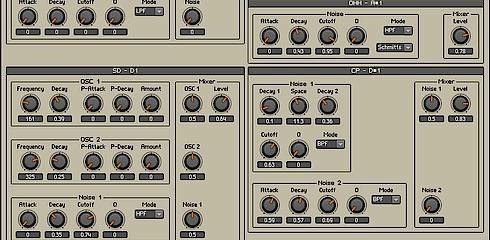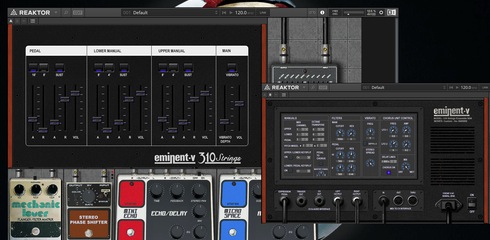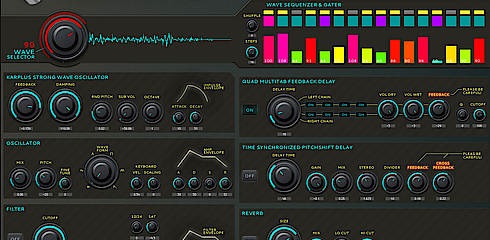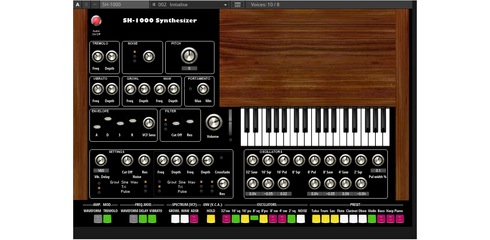Best of Reaktor User Library december 2.016
Blocks
Grain Example Ensemble
by Matthew Friedrichs
This is just an example ensemble that gives a short tour of just one way to use a few Grain blocks in a patch. There are four Grains and four Grain Envelopes being used with one Grain control to act as a master controller for easy sound modulation.
***
TALKBOXKICKER
by Nick Dwyer
Two Monark-based Reaktorblocks making use of those fat generators and filters for an old-fashioned ACIDIC feeling.
TALKBOX uses two LFOs coupled with Infinite Phi’s cascade filter to get that “talking” effect in twelve different presets ranging from quite voice-like to grungey bass-patterned not-at-all voice-like. There are are a few more variations in there but I’ve left it for you to find them!
KICKER is a similar set-up substituting Niji’s KICK for the cascade filter. WHY? Well, I have always found the kick drum the most boring of instruments so I’ve enabled an acid house style tweakage via those oscillators, filters and LFOs that gives you instant tunes and riffs across the keyboard. Give it a go: kick drum programming with a sense of fun.
***
Effects
Megaroom
by Ryan Wilson
A reverb plugin utilizing 96 diffuser delays in groups of 16
***
Samplers
jiTTer-cHain
by Jim Hurley
'jiTTer-cHain' is a set of sample manipulators designed to work together to give you an unlimited number of sample possibilities from a set of 1 to 128 samples.
The main instrument is jiTTer which generates the sample streams. You load your samples there, set the sample range (miN and maX), then set the number of instrument voices. Each voice generates its own sample stream. You will probably find a small number (say from 5 to 20) of voices will give the type of density of sound you like. The notes in the jiTTer sample display describe how to prepare the samples in the sample map.
I put in 128 samples from the MF Auralis ensemble, but you will want to use your own. Even a single sample will work.
I often will take a few samples and put in here, let this run for a while and record the output. Then I take that output and pick more samples to drop in, and repeat as often as you like.
The Global AutoSnap (if turned on) will randomly step through several ensemble snapshots that I like. These snapshots use jiTTer in various pairings with the rest of the instrument chain (some on, some off).
The chain is made up of these UL entries (of which I made many small and large changes):
jiTTer - rick scott
https://www.native-instruments.com/en/reaktor-community/reaktor-user-library/entry/show/4783/
Aural Exciter - Chet Singer
https://www.native-instruments.com/en/reaktor-community/reaktor-user-library/entry/show/6109/
sparDelay v3 - rick scott
https://www.native-instruments.com/en/reaktor-community/reaktor-user-library/entry/show/4823/
g'LitchToo - rick scott
https://www.native-instruments.com/en/reaktor-community/reaktor-user-library/entry/show/5811/
gLitch v5 - rick scott
https://www.native-instruments.com/en/reaktor-community/reaktor-user-library/entry/show/6657/
Mastering Limiter - Guenther Fleischmann
https://www.native-instruments.com/en/reaktor-community/reaktor-user-library/entry/show/5363/
Final Prozessor - Guenther Fleischmann
https://www.native-instruments.com/en/reaktor-community/reaktor-user-library/entry/show/5365/
Ez FFT Christmas Collection - Gabriel Mulzer and Martijn Deluxe and Stephan Schmitt
https://www.native-instruments.com/en/reaktor-community/reaktor-user-library/entry/show/4453/
Auto Snaps based on
eZ randoMize - rick scott
https://www.native-instruments.com/en/reaktor-community/reaktor-user-library/entry/show/2725/
Samples by Jim Hurley from Auralis and effects sample map
https://www.native-instruments.com/en/reaktor-community/reaktor-user-library/entry/show/7753/
***
jiTTer magic stories 1.2
by Paule Amca
granular transformer
Solve the snapshot and got a flomo ambient result: Take my own maps and change the range of speed (0-0,4 auTo) and flow speed (0.1-0.2 auTo), flow rnd (0-0.8 auTo), amp (0.4-0.8 auTo), grain length (0-660 auTo), sample range (0-127 auTo) in the original from 2007 by rachMiel with 8 voices and 20% cpu usage on Reaktor 5.
more maps: http://tinyurl.com/hylygmd
some more snapshots and snaps new button
you can use looped maps with every root note
***
jiTTer-cHain-miNim
by Jim Hurley
This is a stripped-down version of jiTTer-cHain designed to run on slower speed CPUs and laptops. It will seriously alter any sample(s) you feed it. The number of voices in jiTTer determine the number of simultaneous samples playing. I set it to 7 voices - lower the voice count to simplify the sound and decrease CPU loading.
See the UL entry for jiTTer-cHain for more details on the original:
https://www.native-instruments.com/en/reaktor-community/reaktor-user-library/entry/show/10729/
The non-mangling parts of jiTTer-cHain are removed in this version.
Included are 128 global snapshots that randomly select instrument settings. I also included 128 samples, but you should supply your own.
Also included are notes from the Reaktor Forum about jiTTer-cHain.
These snapshots are rather extreme.
Turn off the 'Global AutoSnap' to make it quiet and explore other settings.
Note: The 'tabula rasa' presets are instrument bypasses.
***
Sequencers
AutoDrummer 1.1
by Jim Hurley
AutoDrummer is a self-generative Reaktor toy featuring 3 different MIDI automata: Automato, Spiral and Life. The image on the User Library page shows the different panelsets.
Automato by salamanderanagram (Donald Phillips) provides the MIDI notes for the rest of the ensemble; it can be used by itself, or programmed in turn by Spiral or Life which were both made by Lazyfish (Alexander Potekhin).
The sound generation section consists of an 8 part sample-based Drum machine - 'Gonzzo Classic' from the Reaktor 3 Library by Uwe G. Hoenig followed by a 'Stereo Delay' made by Thomas Medes, followed by the fabulous Laserbrew 1.3 by Tim Schwerdtfeger, followed by the granular Shred 1.0 by Christopher Lenz.
Any or all of the effects may be bypassed and there are many new snapshots for each.
I made modifications to all of these except Automato.
Included are 128 one-shot samples taken from my personal library (but for a few from the Reaktor 3 sample CD). From these I built 14 drum kits and you can easily make your own (with the help of a built-in Drum Tuner if you want pitched samples). A full GM drum assignment is in the sample map, but only 8 samples are used by Gonzzo. It is easy to extend Gonzzo by duplicating the internal samplers as many times as you like.
111 master snapshots are provided to show the variety of sounds that can be made. I don't consider this a drum machine at all, it is really a soundscape or texture generator. I didn't make any effort to provide 'traditional' drum sequences in this ensemble.
There are several panelsets that put the device in different configurations:
1) Automato alone,
2) Automato with effects,
3) the Drum tuner for adjusting Drum sample pitches (turn on in Gonzzo Classic B view),
4) Spiral driving Automato, and
5) Life driving Automato.
The Automato snapshots are oriented towards making drum patterns and note triggers for driving Gonzzo. The Gonzzo snapshots feature the 14 drum sets. The Delay snapshots are oriented towards percussive effects, Laserbrew provides some amazing resonances, reverbs, and distortions, and Shred provides a granular sound quality if that is your poison.
Gonzzo was made fully stereo and uses MicroSpace for its reverb instead of the original reverb design. The B view shows the Drum Tuner - when turned ON it generates a fixed pitch when any note is played.
I added a saturator to Stereo Delay and a few other minor tweaks.
Laserbrew has had a new layout along with the GUI, but the sound has not been changed - I just wanted to study its internal design better. The A view has a bunch of displays added to help make snapshots - the B view is a little simpler. I did add a limiter by James Walker-Hall which is OFF by default. This can help tame wild resonances.
Shred has a number of changes, look at the Info notes to see them.
The two MIDI generators - Spiral and life - are initially muted so that they don't start generating anything (and they use a lot of CPU when ON). They may be displayed in two panelsets, but they won't do anything until you open the structure and UNMUTE the macros that you want to use (one at a time). You can also unmute from the instrument properties.
All the instrument snapshots are managed by the Master snaphot bank, so make sure you are looking at the correct bank when you select a sound - its easy to get lost in the banks.
The first few snapshots introduce the drum sounds, but gradually the snapshots get more adventuresome.
There are separate sections for the drums and effects and for the Spiral and Life patterns.
Spiral is essentially unchanged except that I exposed an inner All Notes Off button if you need it, and a way to turn off MIDI events.
Life was taken from Newscool and seriously bent. I took parts from Spiral and made it do things that no one should be made to read about - truly unspeakable tortures.
These two automatons generate the MIDI notes from 36 to 99 that are used by Automato to start a node in one of the 64 cells.
Since Life can generate up to 1024 MIDI events, it will easily swamp out the CPU if you do the right things. That's why it is turned off.
You can run Spiral and Life together to drive Automato but my CPU is not fast enough to do that. You could break the ensembles apart and place them in a DAW so that they run in separate cores - that exercise is left to the user. The MIDI outs of Spiral and Life are sent internally to Automato.
I wish I could take more credit for this, but most of it was all made by other people - the talented pool of creative Reaktor builders.
***
Synthesizers
CetoneMDrums
by René Jeschke
Analogue mini drum synthesizer for kick, snare, hats and claps. Panel B contains output options.
***
Eminent-V 310 Strings Ensemble MkII 2.1
by Hugo Portillo
Basically this instrument emulates the upper and lower manuals of the strings ensemble section. Also, it adds a pedal section for monophonic bass lines. This is based on the Solina SE not on the 310. Each section has a keyboard split, independent MIDI channel and transpose up to +-3 octaves. Another difference is that I created envelope controls for each string registers to further tweak the sound. If you want a truly 310 behavior leave the envelope sliders at their default values.
The effects section has the standard macros from the library with a different face (Graphic 10 EQ, Micro Space, and Kleinstein Phaser), except the delay which is a cut down version of Michael Wöstefeld’s Michats Space Echo ME-201.
Use the A/B views to switch to the back panel controls to further tweak the sound.
WARNING: With all the effects and manuals on you with get a high CPU usage (+60% on a Pentium D 3.0 GHz)
I made a lame demo going thru most of the presets, everything played live, except Oxygene 6 which is sequenced; therefore, please forgive my lousy playing :-)
If you ever tried to get that “Jarre sound” with this you can get very close.
I would like to thank the following:
- Mark Smart, for his wonderful ARP Omni 2 emulation from which I based the oscillators and chorus units of the Solina-V and Eminent-V 310 => http://www.marksmart.net/
- Radek Tymecki, who kindly provided me with samples of his Eminent 310 and feedback to tweak the oscillators and chorus unit of my instrument => http://www.youtube.com/profile?user=RadekTymecki
http://www.jeanmicheljarre.pl/
- Jürgen Haible, for his JH’s String Ensemble/Triple Chorus Solina chorus unit emulator. Wonderful piece of hardware => http://www.jhaible.heim.at/triple_chorus/triple_chorus.html
- Hertz SM, for his Flat Knobs => http://www.native-instruments.com/index.php?id=userlibrary&type=0&ulbr=1&plview=detail&patchid=3837
- g200kg, for knobman, great utility to create animated knobs and sliders ==> www.g200kg.com/archives/software_knobman_e.html
***
MALLETTA
by Apoidea Instruments
MALLETTA is simple to specialize in decayed sound.
You can make sound with easy operation.
Additional presets : drive with Spiral
https://www.native-instruments.com/jp/reaktor-community/reaktor-user-library/entry/show/10701/
Special thanks to Paule Amca.
***
MTX Synth 1
by Mauro Biagini
Matrix synth
***
Refractor
by Max Pfetscher
Refractor is a synthesizer, based on Karplus Strong synthesis. Instead of using noise as the impulse this synth does use sample-wavetables. Therefore the results are much more experimental, unforeseeable and multifarious. Several delay lines, a multimode filter and special tweaks make this synth unique.
This synth was created for the KVR Developer Challenge 2016.
***
Roland SH1000 emulation v 2.3c
by stuart pryer
The SH-1000 is an emulation of the Roland SH-1000 synthesizer first released in 1973 and which was Roland’s first synth. Its successor was the SH-2000 but that was designed to be more of a preset instrument and had far less flexibility. The SH-1000 was used by Vangelis, Blondie, The Band, Jethrow Tull, The Human League and Eddie Johnson (Roxy Music) as well as many others. This was also the first synth I owned.
It is available as a Native Instruments Reaktor or a NI Reactor Player instrument (if Player is run in demo mode).
My website. Www.stuartpryer.co.uk
***
